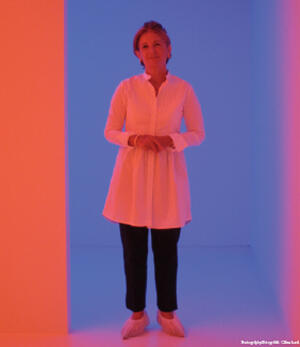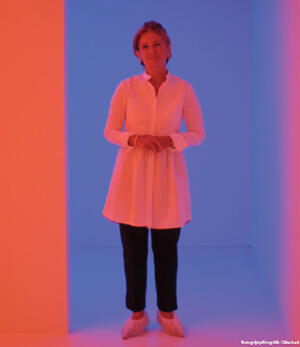PROFILE: Estrellita Brodsky: Rewriting the History of Latin American Art
Estrellita Brodsky´s name is already indissolubly linked to a broadening of the modern and contemporary art discourse towards a more comprehensive vision of Latin American art. She has undertaken this task as an art historian and curator, as a museum consultant, and as a collector and philanthropist determined to expand the presence of this particular field of art in the centers that give shape to the global perception of art.

“In a perfect world,” she emphasizes, “there would be no need for Latin American art departments, for this art would be perfectly integrated.” But she is aware of the fact that as long as the knowledge about Southern creation is insufficient, there will be an imperative need to expand it. The strategy is to reinforce the institutional presence of specialists in Latin American art, as when – thanks to her support to a research program aimed at developing visibility mechanisms for Latin American art – The David Rockefeller Center at Harvard University incorporated Thomas Cummins, Dumbarton Oaks Professor of the History of Pre-Columbian and Colonial Art, or when the Museum of Modern Art of New York, MoMA, accepted the establishment of The Estrellita Brodsky Endowed Fund for Latin American Art, and Luis Pérez-Oramas became the Museum´s first Curator of Latin American Art. “From this position,” Brodsky explains, “he has been able to specifically relate his knowledge of Latin American art with the fields of expertise of other curators, opening windows for interconnection.”
The broadening of a cultural dialogue has an influence on the way in which the works of contemporary Latin American artists are perceived and makes it possible to inscribe in the history of universal art the contribution to modernism made by the South. This rewriting of art implies, for Brodsky, a rigorous analysis of the genesis, nature and implications of Latin American art. Avoiding the visions of an art history in black and white – the risk of facile exaltation or obscurement – she seeks the complex register of “the grays”.
Thus, she addresses the reconstruction of periods like the one to which she dedicated her doctoral thesis under the supervision of Edward Sullivan, at the Institute of Fine Arts, New York University – Post-war Paris between 1950 and 1970 – in which Jesús Soto and Julio Le Parc coincided with a key group of Latin American artists. She is interested in finding out to what extent the fact of living outside their native countries affected the work of these artists, and in reconstructing the complexity of a historical moment. “I am not a critic; I am a historian, and this implies bearing in mind that each history has a maker, someone who determines it.”
On revisiting this passageway that permitted a dialogue between Paris and Montevideo, Buenos Aires or Caracas, Brodsky evaluates the balance between the production originating in these artists´ native countries and the projection of works that aspired to a type of universality which became more viable in those days in that big, cosmopolitan city eager to recover its position as a center for culture. But she also wonders about the prejudices those artists had to face in their transits to and from this metropolis when they brought with them a conception of art that was ´different´ and often criticized.
To broaden history means to incorporate that which has been excluded regarding the way in which the South itself has constructed its history of art. It implies, for instance, revisiting the controversy following the Cuban Revolution between Hispanic critics who attributed to Latin American art a political commitment and those who disagreed with this view. That split affected the perception of abstract geometric artists in the Continent.
Brodsky is also interested in the revision of 20th century art history constructed from outside the continent. She has noticed that in the United States, the Eurocentric focus has been replaced by certain reductionism that leads to a lack of awareness of the simultaneous – and not derivative – character of the relation between American works such as Ellsworth Kelly´s work with color fields and Latin American works such as Cruz-Díez´s chromosaturations. Her curatorial work for the historical exhibition Carlos Cruz Diez: (In)formed by Color, presented at The Americas Society in New York, rescues this unique dialogue between the aesthetic and the social, between the public space and the spectator´s body.
“History is lost so quickly,” a collector once told her. She is concerned with fighting this oblivion, a territory filled with different perspectives, with gray or contradictory areas that refer to the rewriting of chapters of art history in a continent where pages are missing or have been written in a deficient way.
Modeling influences
Since she was a child, Brodsky had wondered at the breach between the reality of Southern cities, where there was a modern world as educated as that of the great cities of the north, and the image of barbarianism with which they were associated. After desisting from her wish of becoming an artist, she studied Literature and Latin American Affairs at Sarah Lawrence College, with the intention of contributing to a better understanding of the culture of countries such as Uruguay, where her mother had been born (she was the great granddaughter of President Juan Idiarte Borda), or Venezuela, where her father, who came from Eastern Europe, had settled down.
Before being admitted to Hunter College, where she majored in Impressionist Art, she worked with Barbara Duncan. Under the guidance of this art historian – the introducer of Torres-García in New York and an early collector of Bonevardi, among other key artists whose works she would donate to the Blanton Museum – Brodsky initiated a crucial apprenticeship. Oddly, the years she devoted to studying the life and work of Gustave Caillebotte were vital for the formation of her vision of the way of exerting an influence on the knowledge of Latin American art. This Impressionist – one of the less known – was remarkable for his interest in rendering interiors with male figures, which was rare in his time, but also for the condition he established when he donated the collection of works by his Impressionist friends to the Luxemburg Museum (later the Musée d' Orsay): that they should be permanently on exhibit. “Having the works of the Latin American artists is not enough: they must be shown,” Brodsky states. Caillebotte helped her understand the historical importance of the interaction among artists, collectors and museums, and the possibility to reactivate it for the benefit of Latin American art.
In 1998, she was recruited by El Museo del Barrio and experienced the satisfaction of contributing as co-organizer to the exhibition Taíno: Pre-Columbian Art and Culture from the Caribbean, which implied the rediscovery of the genesis of art in Puerto Rico, Jamaica, Haiti, the Dominican Republic and Cuba. And for the sake of this rediscovery, the dissolution of political frontiers in order to recover the common past contained in Pre-Columbian art. “Art,” she assures, “unites people, and being exposed to art renders us more sensitive; it humanizes us. That is why I think it is important to view works directly.” Awareness of the scanty resources with which this museum, which currently plays a key role in the representation of Latin American culture in the United States worked, led her to preside the Advisory Board and to become actively involved in the fundraising activities at the annual gala.
At the same time, she contributed to the major exhibition of MoMA´s Collection of Latin American Art at El Museo del Barrio: ”Showing to the city the works that were in storage, the early works by Lygia Clark and Ligia Pape, Oiticica and Goertiz, or Le Parc and Wifredo Lam, was impressive: They had not been seen this way before."
Working as an independent researcher/curator, serving as advisor for MoMA´s International Council and member of the Latin American and Caribbean Acquisition Fund, or supporting fairs such as Pinta, Estrellita Brodsky fulfills an irreplaceable mission: “To open the modern and contemporary art discourse to a perspective of Latin American art that permits not only its exhibition and appreciation at a global level, but also its protection as patrimony of the continent.”




